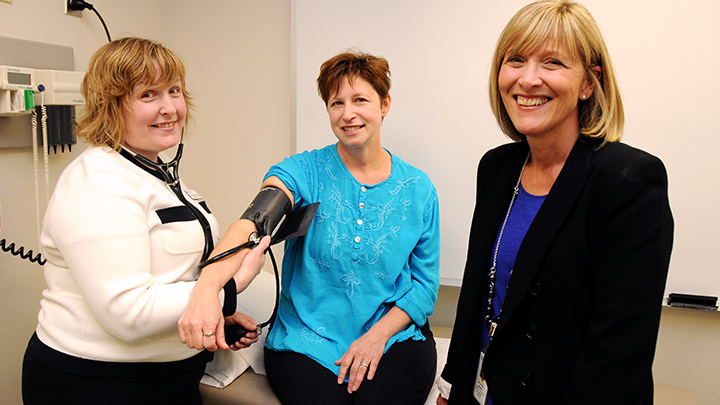
May 10, 2016

Dr. Kara Nerenberg, left, an AHS specialist in hypertensive disorders during pregnancy, and Dr. Jo-Ann Johnson, right, Head of Maternal Fetal Medicine at Foothills Medical Centre, meet with Micheline Fulop, who developed preeclampsia while carrying her first child.
Story and photo by Greg Harris
CALGARY — As she awaited her first child, everything about Micheline Fulop’s pregnancy felt perfectly normal — right up until the night she went to the Foothills Medical Centre emergency department with stomach pains.
Initially, it was unclear what her condition was, but when she returned for an ultrasound the next day, doctors determined she had a form of preeclampsia, or high blood pressure in pregnancy.
“I was oblivious to the gravity of the situation until the doctors explained, ‘We have to get this baby out’,” says “Fulop. “Apparently my liver could have burst, or my retinas detached, or I might have even stroked out.”
If left untreated, preeclampsia can be fatal for mothers and their developing babies. It can also lead to serious complications, including pre-term birth.
Now, researchers in Calgary are hoping a new study will help them predict which first-time moms are at risk of developing preeclampsia early in their pregnancies.
They are testing a new prediction algorithm that takes into account a combination of factors such as personal history, body mass index, blood pressure, ultrasound findings and indicators of placental function in order to determine preeclampsia risk.
“The prediction tool was developed by the Fetal Medicine Foundation in the U.K. and, while it appears very effective, it has not been validated for use in the Canadian population,” says Dr. Jo-Ann Johnson, AHS Head of Maternal Fetal Medicine at Foothills Medical Centre and the Calgary site lead for the three-year, multi-centre national study.
“If we can reliably identify which women are at increased risk of early onset preeclampsia (before 34 weeks of gestation), we can ensure they get the proper care early on to prevent complications from developing,” adds Dr. Johnson, who is also a professor of obstetrics and gynecology in the University of Calgary’s Cumming School of Medicine.
Today Fulop’s daughter Ryan is in Grade 1. She was born at 33 weeks and weighed four pounds, six ounces. (A baby is considered pre-term if born before 37 weeks of pregnancy.)
“There had never been any high blood pressure issues in the family,” says Fulop. “This totally blindsided me. If research like this can help prevent women from going through what I had to go through, then it’s certainly well worth it.”
Preeclampsia affects about one in every 20 pregnancies. It’s estimated there are fewer than five preventable maternal deaths in Canada every year due to preeclampsia; worldwide, however, it’s a much more significant problem with about 70,000 women dying each year.
Dr. Kara Nerenberg, an AHS specialist in hypertensive disorders of pregnancy, says the prediction tool, if it can be validated, will give doctors an important diagnostic aid.
“Preeclampsia can also contribute to the development of other cardiovascular problems later in life in these women, so prevention will have value that goes well beyond making their pregnancies safer,” says Dr. Nerenberg, a member of the Libin Cardiovascular Institute of Alberta.
As part of the preeclampsia prediction study, Drs. Nerenberg, Todd Anderson, Johnson and other researchers are looking at how well the endothelium — the inner lining of the blood vessels — functions in women at risk of preeclampsia.
For information on how to participate in the study, please contact Tess Topor at 403-943-8382, or email predictioncalgary@gmail.com